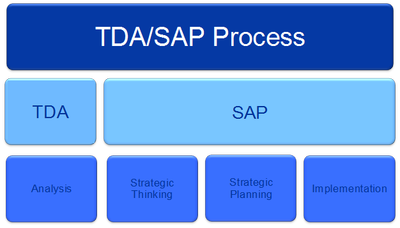3.2 - Introduction
What is the GEF TDA/SAP Approach?
The Transboundary Diagnostic Analysis/Strategic Action Programme (TDA/SAP) approach is a highly collaborative process that has proven to be a major strategic planning tool for GEF International Waters Projects over the last 16 years.
The main technical role of a TDA is to identify, quantify, and set priorities for environmental problems that are transboundary in nature. In particular, the TDA aims to:
Identify & prioritise the transboundary problems
- Gather and interpret information on the environmental impacts and socio-economic consequences of each problem
- Analyse the immediate, underlying, and root causes for each problem, and in particular identify specific practices, sources, locations, and human activity sectors from which environmental degradation arises or threatens to arise.
Consequently, a TDA provides the factual basis for the formulation of an SAP. In addition to this, however, the TDA should be part of a process of engagement of stakeholders through the initial TDA development steps and the subsequent development of alternative solutions during the formulation of the SAP.
The SAP is a negotiated policy document that should be endorsed at the highest level of all relevant sectors of government. It establishes clear priorities for action (for example, policy, legal, institutional reforms, or investments) to resolve the priority transboundary problems identified in the TDA. A key element of the SAP is a well-defined baseline. This enables a clear distinction between actions with purely national benefits and those addressing transboundary concerns with global benefits. Another key element involves the development of institutional mechanisms at the regional and national levels for implementing the SAP and monitoring and evaluation procedures to measure effectiveness of the outcomes of the process.
What Does It Comprise Of?
A simple schematic of the process is outlined below:

Figure 1: Schematic outline of the TDA/SAP process
As can be seen from the schematic above, the TDA/SAP process comprises 2 major components. These are:
- The TDA: The analytical component comprising of a technical analysis of transboundary problems, impacts and causes
- The SAP: The strategic component comprising of strategic thinking, planning and implementation
Ultimately, the TDA/SAP process is part of a larger adaptive management cycle. This consists of four key steps: involves assessing the problem (through the TDA); formulating a strategic plan with robust indicators (through the SAP); implementing the actions identified in the SAP and finally monitoring the outcomes, both short-term and long-term and adapting the plan accordingly (TDA and SAP revision).

Figure 2: The TDA/SAP process as part of a four-step adaptive management cycle
The Analytical Component – The TDA
The main technical role of a TDA is to identify, quantify, and set priorities for environmental problems that are transboundary in nature. The key steps in the TDA development process are:
- Definition of system boundaries
- Collection and analysis of data/information
- Identification & prioritisation of the transboundary problems
- Determination of the environmental and socio-economic impacts
- Analysis of the immediate, underlying, and root causes
- Development of thematic reports
- Identification of leverage points
- Drafting the TDA
The TDA provides the factual basis for the strategic component of the TDA/SAP Process – strategic thinking, planning and implementation of the SAP. In addition to this, the TDA should be part of a larger facilitative process of engagement and consultation with all the key stakeholders from the initial TDA steps through to the subsequent development of alternative solutions during the formulation of the Strategic Action Programme.
|
Note: The TDA is a mechanism to help the participating countries to 'agree on the facts' - many conflicts are driven by perceptions and removing these can be an enormous step in itself. Furthermore, the TDA should be seen as more than just an analysis of data and information. It is a powerful process that can help create confidence among the partners involved. |
|---|
The Strategic Component – The SAP
The SAP is a negotiated policy document that should be endorsed at the highest level of all relevant sectors. It establishes clear priorities for action (for example, policy, legal, institutional reforms, or investments) to resolve the priority transboundary problems identified in the TDA.
The preparation of a SAP should be a highly cooperative and collaborative process among the countries of the region. The strategic component of the SAP process has 2 key phases:
- Defining the vision
- Setting goals or status statements
- Brainstorming new ideas/opportunities for innovation
- Identifying options or alternatives
- National and regional consultation processes
- Setting strategies for implementation
- Action planning - Setting actions, timescales, priorities and indicators
- Drafting the SAP
- Steps towards SAP implementation
A key element of the SAP is a well-defined baseline. This enables a clear distinction between actions with purely national benefits and those addressing transboundary concerns with global benefits. Another key element involves the development of institutional mechanisms at the regional and national levels for implementing the SAP and monitoring and evaluation procedures to measure effectiveness of the outcomes of the process.

























